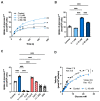Lithium Enhances Hippocampal Glucose Metabolism in an In Vitro Mice Model of Alzheimer's Disease
- PMID: 35955868
- PMCID: PMC9368914
- DOI: 10.3390/ijms23158733
Lithium Enhances Hippocampal Glucose Metabolism in an In Vitro Mice Model of Alzheimer's Disease
Abstract
Impaired cerebral glucose metabolism is an early event that contributes to the pathogenesis of Alzheimer's disease (AD). Importantly, restoring glucose availability by pharmacological agents or genetic manipulation has been shown to protect against Aβ toxicity, ameliorate AD pathology, and increase lifespan. Lithium, a therapeutic agent widely used as a treatment for mood disorders, has been shown to attenuate AD pathology and promote glucose metabolism in skeletal muscle. However, despite its widespread use in neuropsychiatric disorders, lithium's effects on the brain have been poorly characterized. Here we evaluated the effect of lithium on glucose metabolism in hippocampal neurons from wild-type (WT) and APPSwe/PS1ΔE9 (APP/PS1) mice. Our results showed that lithium significantly stimulates glucose uptake and replenishes ATP levels by preferential oxidation of glucose through glycolysis in neurons from WT mice. This increase was also accompanied by a strong increase in glucose transporter 3 (Glut3), the major carrier responsible for glucose uptake in neurons. Similarly, using hippocampal slices from APP-PS1 mice, we demonstrate that lithium increases glucose uptake, glycolytic rate, and the ATP:ADP ratio in a process that also involves the activation of AMPK. Together, our findings indicate that lithium stimulates glucose metabolism and can act as a potential therapeutic agent in AD.
Keywords: Alzheimer’s disease; glucose; lithium; metabolism.
Conflict of interest statement
The authors declare that they have no competing interest concerning the contents of this article.
Figures






Similar articles
-
ABCA7 Deficiency Accelerates Amyloid-β Generation and Alzheimer's Neuronal Pathology.J Neurosci. 2016 Mar 30;36(13):3848-59. doi: 10.1523/JNEUROSCI.3757-15.2016. J Neurosci. 2016. PMID: 27030769 Free PMC article.
-
Long-term running exercise improves cognitive function and promotes microglial glucose metabolism and morphological plasticity in the hippocampus of APP/PS1 mice.J Neuroinflammation. 2022 Feb 5;19(1):34. doi: 10.1186/s12974-022-02401-5. J Neuroinflammation. 2022. PMID: 35123512 Free PMC article.
-
Evaluation of Neuropathological Effects of a High-Fat Diet in a Presymptomatic Alzheimer's Disease Stage in APP/PS1 Mice.J Alzheimers Dis. 2016 Jul 14;54(1):233-51. doi: 10.3233/JAD-160150. J Alzheimers Dis. 2016. PMID: 27567882
-
Increasing brain glucose metabolism by ligustrazine piperazine ameliorates cognitive deficits through PPARγ-dependent enhancement of mitophagy in APP/PS1 mice.Alzheimers Res Ther. 2022 Oct 11;14(1):150. doi: 10.1186/s13195-022-01092-7. Alzheimers Res Ther. 2022. PMID: 36217155 Free PMC article.
-
Age- and Sex-Associated Glucose Metabolism Decline in a Mouse Model of Alzheimer's Disease.J Alzheimers Dis. 2022;87(2):901-917. doi: 10.3233/JAD-215273. J Alzheimers Dis. 2022. PMID: 35404275
Cited by
-
Why Is Iron Deficiency/Anemia Linked to Alzheimer's Disease and Its Comorbidities, and How Is It Prevented?Biomedicines. 2023 Aug 30;11(9):2421. doi: 10.3390/biomedicines11092421. Biomedicines. 2023. PMID: 37760862 Free PMC article. Review.
-
Lithium Prevents Telomere Shortening in Cortical Neurons in Amyloid-Beta Induced Toxicity.NeuroSci. 2022 Dec 23;4(1):1-8. doi: 10.3390/neurosci4010001. eCollection 2023 Mar. NeuroSci. 2022. PMID: 39484296 Free PMC article.
-
Molecular mechanisms and therapeutic potential of lithium in Alzheimer's disease: repurposing an old class of drugs.Front Pharmacol. 2024 Jul 11;15:1408462. doi: 10.3389/fphar.2024.1408462. eCollection 2024. Front Pharmacol. 2024. PMID: 39055498 Free PMC article. Review.
-
Metabolic plasticity: an evolutionary perspective on metabolic and circadian dysregulation in bipolar disorder.Mol Psychiatry. 2025 Jul 19. doi: 10.1038/s41380-025-03123-9. Online ahead of print. Mol Psychiatry. 2025. PMID: 40681844 Review.
-
Multiple Mechanisms and Therapeutic Strategies for the Involvement of AMPK in the Development of Alzheimer's Disease.Mol Neurobiol. 2025 Jul 15. doi: 10.1007/s12035-025-05162-3. Online ahead of print. Mol Neurobiol. 2025. PMID: 40665063 Review.
References
MeSH terms
Substances
Grants and funding
LinkOut - more resources
Full Text Sources
Medical

